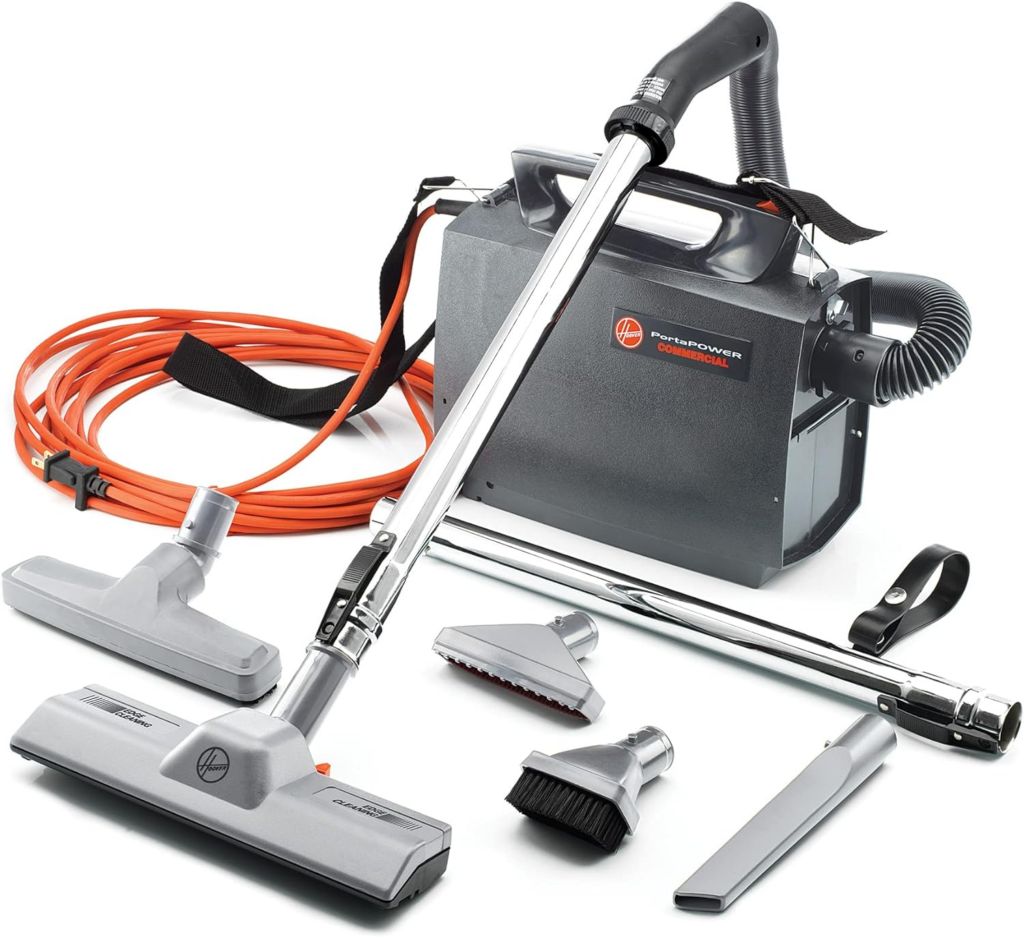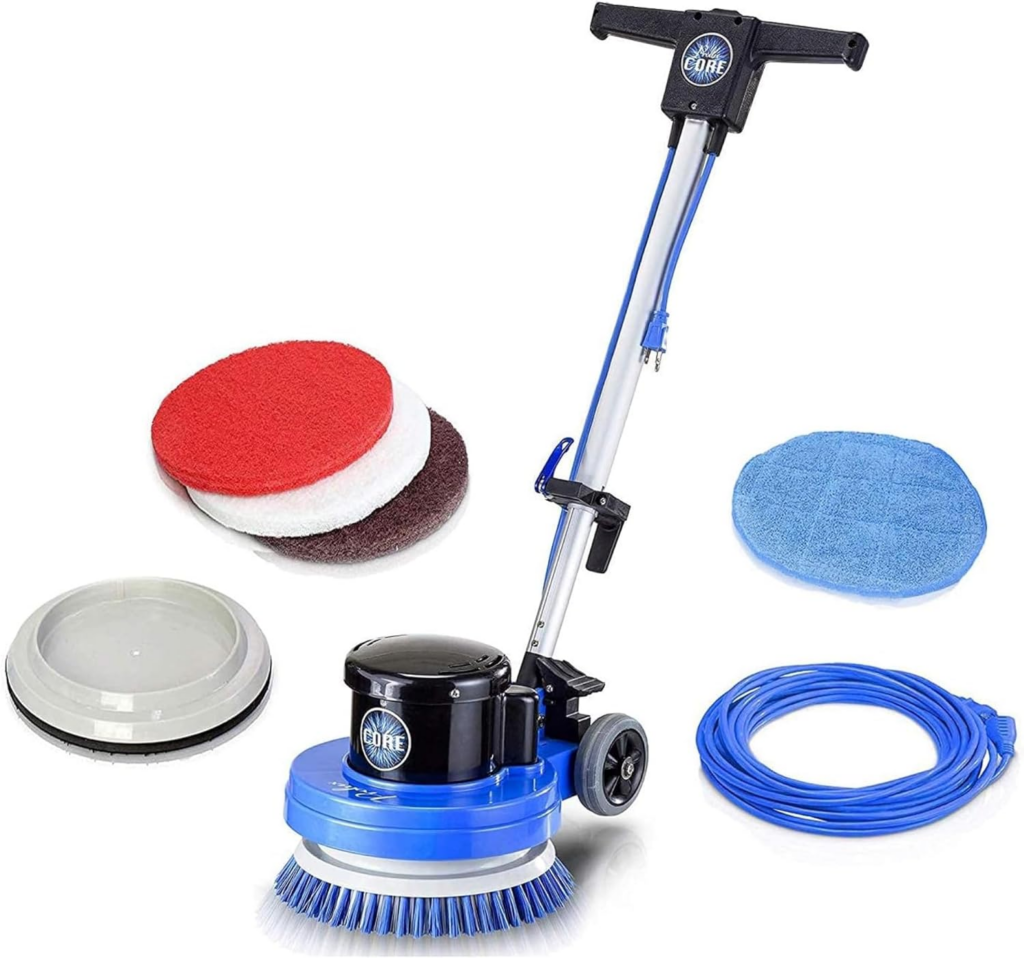Looking to maintain a spotless restaurant and kitchen? Having the proper products and equipment is key to achieving a pristine environment. This blog post will delve into some essential restaurant cleaning supplies and equipment. Let’s take a look!
Table of Contents
Commercial-Grade Vacuum Cleaner

A professional cleaning specialist knows how vital a high-quality commercial-grade vacuum cleaner is. It’s critical to keep a restaurant tidy and free of food crumbs, dust, and other debris in tight spaces.
From the table, the suction power ranges from 900 to 1,200 watts. The higher the wattage, the stronger the suction.
Also, commercial-grade vacuum cleaners have additional features like HEPA filters and antimicrobial coatings for maximum sanitation.
Buying an excellent commercial-grade vacuum cleaner saves money on costly repairs or replacements in the long run and accelerates cleaning time for staff.
Mop and Bucket

Restaurant hygiene is essential – and the wet cleaning system is a must for any eatery. Get the right mopping gear – choose from microfiber, cotton or synthetic fibers. Plus, a bucket with a wringer is essential for successful cleaning. To save time, upgrade to a floor scrubber. And be sure to clean your mop after every use – to thwart bacteria and increase its longevity.
To keep patrons happy, a sparkling restaurant is key. Make it sparkle with the help of microfiber cloths and sponges.
Microfiber Cloths and Sponges

Microfiber cloths and sponges are indispensable for restaurant hygiene. They trap dust, dirt, and grime with just water. And, they last up to 10 times longer than regular sponges! Plus, they are reusable and economical.
Microfiber cloths and sponges also prevent cross-contamination and save time, as they easily clean stubborn stains.
Say goodbye to grease and grime with this heavy-duty degreaser and sanitizer – for sparkling clean dining scenes!
Heavy-duty Degreaser and Sanitizer

The Heavy-duty Degreaser and Sanitizer is a must-have for restaurants. Without it, hygiene standards may slip, leading to health risks for customers and staff.
Check out this table of popular kitchen cleaning equipment:
…… (continue with other columns)
| Equipment | Use | Benefits |
| Heavy-duty Degreaser and Sanitizer | Cuts grease and sanitizes surfaces | Kills bacteria and prevents grime build-up |
| Vacuum cleaner | Sucks up waste without leaving traces | Saves time and energy compared to manual work. |
Using the correct concentration of this degreaser also helps conserve water when cleaning. It’s clear that the Heavy-duty Degreaser and Sanitizer is essential for keeping restaurants uncontaminated by killing bacteria and removing tough grease.
Pressure washers and steam cleaners are also must-haves.
Pressure Washer or Steam Cleaner

A powerful cleaning machine to tackle hard-to-remove dirt and grime in restaurants is often desired. Pressure washers and steam cleaners are two popular options. Below is a comparison of the two based on performance, cost, maintenance, and cleaning applications.
| Pressure Washer | Steam Cleaner | |
| Performance | Grease and tough stains from concrete and equipment? No problem! | Cleans grout, tiles, hoods, ovens, and tight spaces. |
| Cost | Moderate price, average running and maintenance costs. | Pricey, but electricity consumption is high. |
| Maintenance | Tune-ups for smooth motor running. | Boiler must be drained daily. |
| Cleaning Applications | Outdoor patios, decks, sidewalks and other exteriors. | Tabletops, non-porous surfaces, and cooking equipment. |
Remember: these gadgets require proper training and following instructions. Cleanliness is key for restaurants. Pressure washers and steam cleaners help keep food service top-notch and customers happy. Plus, you get a good workout pushing around a floor scrubber or buffer!
Floor Scrubber or Buffer

For successful cleaning in a restaurant, special cleaning equipment is essential. One key tool for correctly cleaning and taking care of restaurant floors is the ‘Floor Scrubber or Buffer’ machine.
See the following table for accurate and true details about this invaluable cleaning device.
| Column 1 | Column 2 |
|---|---|
| Floors Cleaned | Tile, Hardwood, Concrete |
| Cleaning Path Width | 15 inches to 26 inches |
| Power Source | Electric or Battery Operated |
Apart from its main purpose, floor scrubbers have features that enrich their performance. They are made with robust brushes that deliver deep cleaning while preventing any harm. Plus, some are compactly designed which works great in confined spaces like behind bars or between tables. This lets quick and easy cleaning without disturbing customers’ dining experience.
Cleanliness is important, but having the perfect restaurant cleaning equipment is the key to success in the food industry.
Conclusion
The right cleaning gear in a restaurant is vital. With the right stuff, cleanliness and hygiene standards can be met. High-quality mops, buckets, and cleaning solutions are all important. Commercial steam cleaners, pressure washers, and floor machines can help with tougher tasks. Investing in the necessary items improves customer health and creates a great dining atmosphere.
Using the right techniques with the equipment is also key. Doing so maximizes effectiveness, reduces risks, and saves time, energy, labor, and money. In conclusion, every piece of equipment plays a crucial role in keeping your restaurant healthy, clean, and inviting to customers.
Frequently Asked Questions
1. What are the essential restaurant cleaning equipment?
There are several types of essential restaurant cleaning equipment, including mop and bucket, broom and dustpan, vacuum cleaner, scrub brush, cleaning cloths and sponges, and cleaning chemicals.
2. What are the benefits of using restaurant cleaning equipment?
The benefits of using restaurant cleaning equipment include maintaining hygiene and cleanliness, minimizing the risk of food contamination, ensuring a healthy working environment for employees, and complying with health and safety regulations.
3. How often should restaurant cleaning equipment be cleaned and sanitized?
The frequency of cleaning and sanitizing restaurant cleaning equipment depends on the type of equipment, how often it is used, and the industry regulations. However, it is recommended to clean and sanitize daily or after every use to ensure proper hygiene and cleanliness.
4. What types of cleaning chemicals should be used in a restaurant?
Cleaning chemicals commonly used in restaurants include degreasers, all-purpose cleaners, disinfectants, and sanitizers. It is important to use chemical cleaners that are safe and effective for the type of surface being cleaned and follow manufacturer instructions and recommended dilutions.
5. How should cleaning equipment be stored to maintain their effectiveness?
Cleaning equipment should be stored in a dry and clean area away from potential contaminants. Brooms and mops should be hung up or placed upright to dry. Vacuum cleaners should be emptied regularly and stored in a secure location. Cleaning cloths and sponges should be washed and disinfected after each use and stored in a clean and dry place.
6. What is the importance of using proper cleaning equipment and techniques?
Using proper cleaning equipment and techniques ensures that restaurant surfaces are free from harmful bacteria, viruses, and other contaminants. It reduces the risk of foodborne illnesses and keeps employees and customers safe and healthy. Proper cleaning techniques also prolong the lifespan of equipment and save money on unnecessary repairs and replacements.

